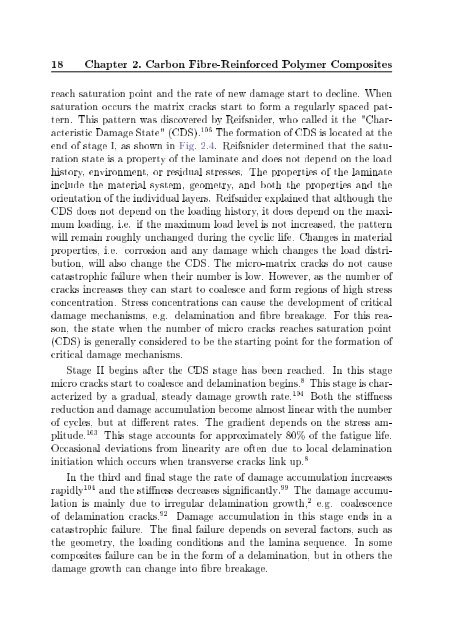Acoustic Emission Monitoring of CFRP Laminated Composites ...
Acoustic Emission Monitoring of CFRP Laminated Composites ...
Acoustic Emission Monitoring of CFRP Laminated Composites ...
You also want an ePaper? Increase the reach of your titles
YUMPU automatically turns print PDFs into web optimized ePapers that Google loves.
18 Chapter 2. Carbon Fibre-Reinforced Polymer <strong>Composites</strong><br />
reach saturation point and the rate <strong>of</strong> new damage start to decline. When<br />
saturation occurs the matrix cracks start to form a regularly spaced pattern.<br />
This pattern was discovered by Reifsnider, who called it the "Characteristic<br />
Damage State" (CDS). 106<br />
The formation <strong>of</strong> CDS is located at the<br />
end <strong>of</strong> stage I, as shown in Fig. 2.4. Reifsnider determined that the saturation<br />
state is a property <strong>of</strong> the laminate and does not depend on the load<br />
history, environment, or residual stresses. The properties <strong>of</strong> the laminate<br />
include the material system, geometry, and both the properties and the<br />
orientation <strong>of</strong> the individual layers. Reifsnider explained that although the<br />
CDS does not depend on the loading history, it does depend on the maximum<br />
loading, i.e. if the maximum load level is not increased, the pattern<br />
will remain roughly unchanged during the cyclic life. Changes in material<br />
properties, i.e. corrosion and any damage which changes the load distribution,<br />
will also change the CDS. The micro-matrix cracks do not cause<br />
catastrophic failure when their number is low. However, as the number <strong>of</strong><br />
cracks increases they can start to coalesce and form regions <strong>of</strong> high stress<br />
concentration. Stress concentrations can cause the development <strong>of</strong> critical<br />
damage mechanisms, e.g. delamination and bre breakage. For this reason,<br />
the state when the number <strong>of</strong> micro cracks reaches saturation point<br />
(CDS) is generally considered to be the starting point for the formation <strong>of</strong><br />
critical damage mechanisms.<br />
Stage II begins after the CDS stage has been reached. In this stage<br />
micro cracks start to coalesce and delamination begins. 8<br />
This stage is characterized<br />
by a gradual, steady damage growth rate. 104<br />
Both the stiness<br />
reduction and damage accumulation become almost linear with the number<br />
<strong>of</strong> cycles, but at dierent rates. The gradient depends on the stress amplitude.<br />
103<br />
This stage accounts for approximately 80% <strong>of</strong> the fatigue life.<br />
Occasional deviations from linearity are <strong>of</strong>ten due to local delamination<br />
initiation which occurs when transverse cracks link up. 8<br />
In the third and nal stage the rate <strong>of</strong> damage accumulation increases<br />
rapidly 104 and the stiness decreases signicantly. 99 The damage accumulation<br />
is mainly due to irregular delamination growth, 2<br />
e.g. coalescence<br />
<strong>of</strong> delamination cracks. 92<br />
Damage accumulation in this stage ends in a<br />
catastrophic failure. The nal failure depends on several factors, such as<br />
the geometry, the loading conditions and the lamina sequence. In some<br />
composites failure can be in the form <strong>of</strong> a delamination, but in others the<br />
damage growth can change into bre breakage.

















